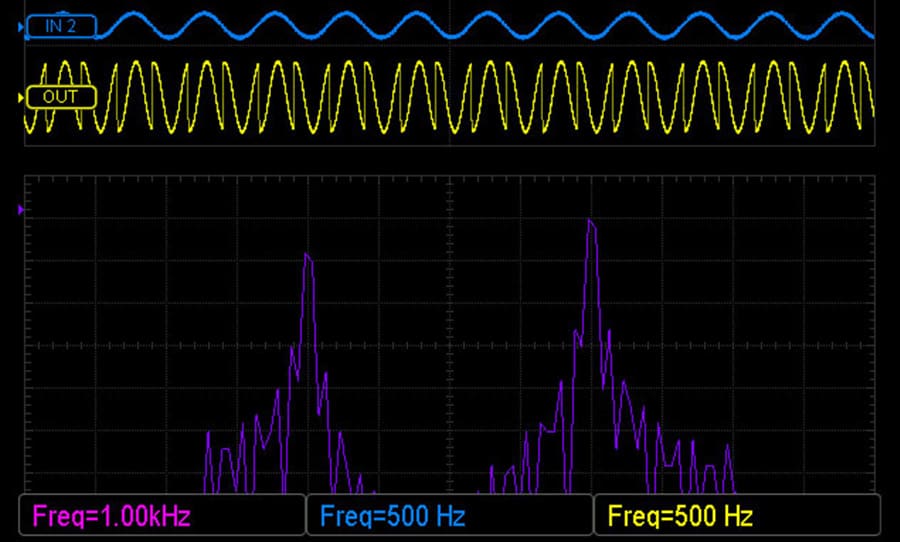Ring modulation is one of the most bizarre effects out there. And like most weird things, it is often misunderstood. Let’s take a look at the history of the original space sound and it’s uses in modern music.
There have been numerous examples in the history of recorded sound where an audio phenomenon has gone on to change the way in which music is created and heard. From pushing guitar amps past their limits resulting in distortion, to manipulating the loops of tape recording systems to achieve a delay effect, experimentation has blurred the boundaries of modern music.
A lesser known yet equally intriguing illustration of this is the case of ring modulation. With an air of mystery surrounding it, this bizarre effect has made its way into recordings that you are bound to have listened to, whether you realise it or not.

Ring modulation is an amplitude modulation effect that occurs when two signals are multiplied, typically one sine wave or another type of simple waveform and a ‘carrier wave’. The term ‘ring modulation’ comes from the actual shape the analog circuit resembles – a ring of diodes.
This process creates two brand new frequencies and what you are left with is the sum and difference of the inputted frequencies. In practical terms, the resulting sounds are not harmonically related; the signals generated through the process of ring modulation are in many ways, brutish and non-musical.
However, the way in which this effect has been applied in music historically lends to a method of processing that is uniquely different, yet useable in far many more contexts than you would possibly think.
Even though the origin of ring modulation goes back to analogue telephone applications, it wasn’t long after this that it was utilised outside of communication systems, and as early as the late 1940’s and into the 1950’s, ring modulators were being used in emerging electronic music.
Around the same time, electronic instrument pioneer Harald Bode had invented the Melochord, a two-tone melody keyboard instrument that had its own ring modulation section for harmonics.
Despite the fringe use of ring modulation in avant-garde circles at the time, the effect’s mass-market debut was soon to come, featuring heavily in the historically influential and ground breaking science fiction film Forbidden Planet (1956).
The film’s composers Bebe and Louis Barron were able to create a pioneering soundscape that was otherworldly and far removed from anything that had been composed to date. Not only had the couple written a score that was the first of its kind, most of the equipment they used was built from scratch, notably the circuits that generated the ring modulation effect. They were able to take what was originally seen as just tonal effect and apply it with style, to create movement and evoke emotion and this in many ways became the backbone of the film.
Such critical acclaim arose out of this new method of audio manipulation that it was inevitable that the sound of ring modulation would surface again, and when the effect was used to voice the ‘bloops’ and ‘bleeps’ of the Daleks in the cult classic British television show Doctor Who, it had cemented its place in music and screen history.
The infamous solo from Paranoid by Black Sabbath is one example where the effect is subtly introduced, combined with stuttering tremolo, to create a sound that is somewhat foreign yet altogether fitting.
In the case of this particular song, it is speculated that Tony Iommi ran his guitar signal through a Moog or perhaps ARP 2500 modular synth, as this was one of the only ways at the time to harness the effect for guitar.
As the popularity of ring modulation increased, there became a need for a more convenient application of the effect and over the years iconic ring modulator stompboxes have been introduced for this purpose alone. These have included the classic Electro-Harmonix Frequency Analyzer, released in the early 70’s, and more recently the Moog MF-102, a descendent of the original modular synth, whose creator Robert Moog in fact applied the ideas formulated in Harald Bode’s early work.
These days ring mod sounds can be accessed through multi-effect pedals and plug-ins, and there is even greater control over the outputted signal as it becomes a studio tool with tweakability and control.
While ring modulation is an eccentric effect, its use in music has been historically prevalent, and as digital stability has become more preferred in modern music, perhaps it is time artists and producers revisit the unpredictability of a bunch of basic circuits to make noise and create something unique; perhaps even iconic.


